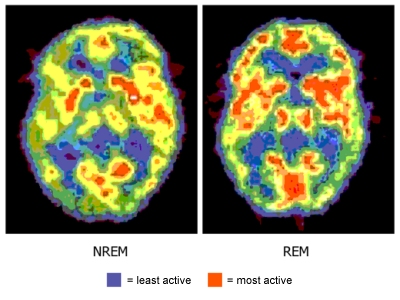
Image via MUSE Science Magazine for Kids.
Do animals dream? Since you can’t observe another creature’s dreams directly, there’s really no way to know for sure if it’s dreaming. But, since the 1950s, scientists have found some pretty convincing, though indirect, evidence that many other mammals and birds do indeed dream.
Part of the evidence stems from what we call Rapid Eye Movement sleep, or REM sleep, which was discovered in 1953. In humans, this stage of sleep corresponds with being in a dream state. During REM sleep, your eyes dart back and forth, you can’t move much, and there’s lots of electrical activity going on in your brain.

Image via howsleepworks.com.
After identifying REM sleep in humans, scientists soon began studying it in animals. Almost all mammals and birds that have been studied – from dogs and cats to duck-billed platypuses, and even reptiles – seem to go into this stage of Rapid Eye Movement sleep. The patterns of electrical activity in the animals’ brains during this stage are similar to those of humans. So, if these patterns show that humans are dreaming, then it might be that these animals are dreaming, too.
Studies have shown that cats who were altered to move during REM sleep ran around, swatted their paws and bit at imaginary objects. So, if the evidence is correct, and cats do dream, we have some idea of what they might dream about! In the video below, a mother cat appears to be comforting her kitten, after it has a nightmare:
A 2001 study in the journal Neuron compared the brain patterns of rats running through a maze with their brain patterns during REM sleep. The scientists said the brain patterns were very similar and concluded the rats were dreaming about their run through the maze.
A 2015 study in the journal eLife confirmed this idea. It showed that when lab rats are shown food and then go to sleep, certain cells in their brains seemed to map out how to get to the food.
So it seems that animals do dream, but – in the context of our current science – we still can’t say for certain.
The video below – from National Geographic – shows some of the funny ways that animals sleep …
Bottom line: The evidence is convincing, though indirect, that many animals do dream.
Image via New Daily.
EarthSky lunar calendars are cool! They make great gifts. Order now.
from EarthSky http://bit.ly/2kBf7Dm

Image via MUSE Science Magazine for Kids.
Do animals dream? Since you can’t observe another creature’s dreams directly, there’s really no way to know for sure if it’s dreaming. But, since the 1950s, scientists have found some pretty convincing, though indirect, evidence that many other mammals and birds do indeed dream.
Part of the evidence stems from what we call Rapid Eye Movement sleep, or REM sleep, which was discovered in 1953. In humans, this stage of sleep corresponds with being in a dream state. During REM sleep, your eyes dart back and forth, you can’t move much, and there’s lots of electrical activity going on in your brain.

Image via howsleepworks.com.
After identifying REM sleep in humans, scientists soon began studying it in animals. Almost all mammals and birds that have been studied – from dogs and cats to duck-billed platypuses, and even reptiles – seem to go into this stage of Rapid Eye Movement sleep. The patterns of electrical activity in the animals’ brains during this stage are similar to those of humans. So, if these patterns show that humans are dreaming, then it might be that these animals are dreaming, too.
Studies have shown that cats who were altered to move during REM sleep ran around, swatted their paws and bit at imaginary objects. So, if the evidence is correct, and cats do dream, we have some idea of what they might dream about! In the video below, a mother cat appears to be comforting her kitten, after it has a nightmare:
A 2001 study in the journal Neuron compared the brain patterns of rats running through a maze with their brain patterns during REM sleep. The scientists said the brain patterns were very similar and concluded the rats were dreaming about their run through the maze.
A 2015 study in the journal eLife confirmed this idea. It showed that when lab rats are shown food and then go to sleep, certain cells in their brains seemed to map out how to get to the food.
So it seems that animals do dream, but – in the context of our current science – we still can’t say for certain.
The video below – from National Geographic – shows some of the funny ways that animals sleep …
Bottom line: The evidence is convincing, though indirect, that many animals do dream.
Image via New Daily.
EarthSky lunar calendars are cool! They make great gifts. Order now.
from EarthSky http://bit.ly/2kBf7Dm

Aucun commentaire:
Enregistrer un commentaire